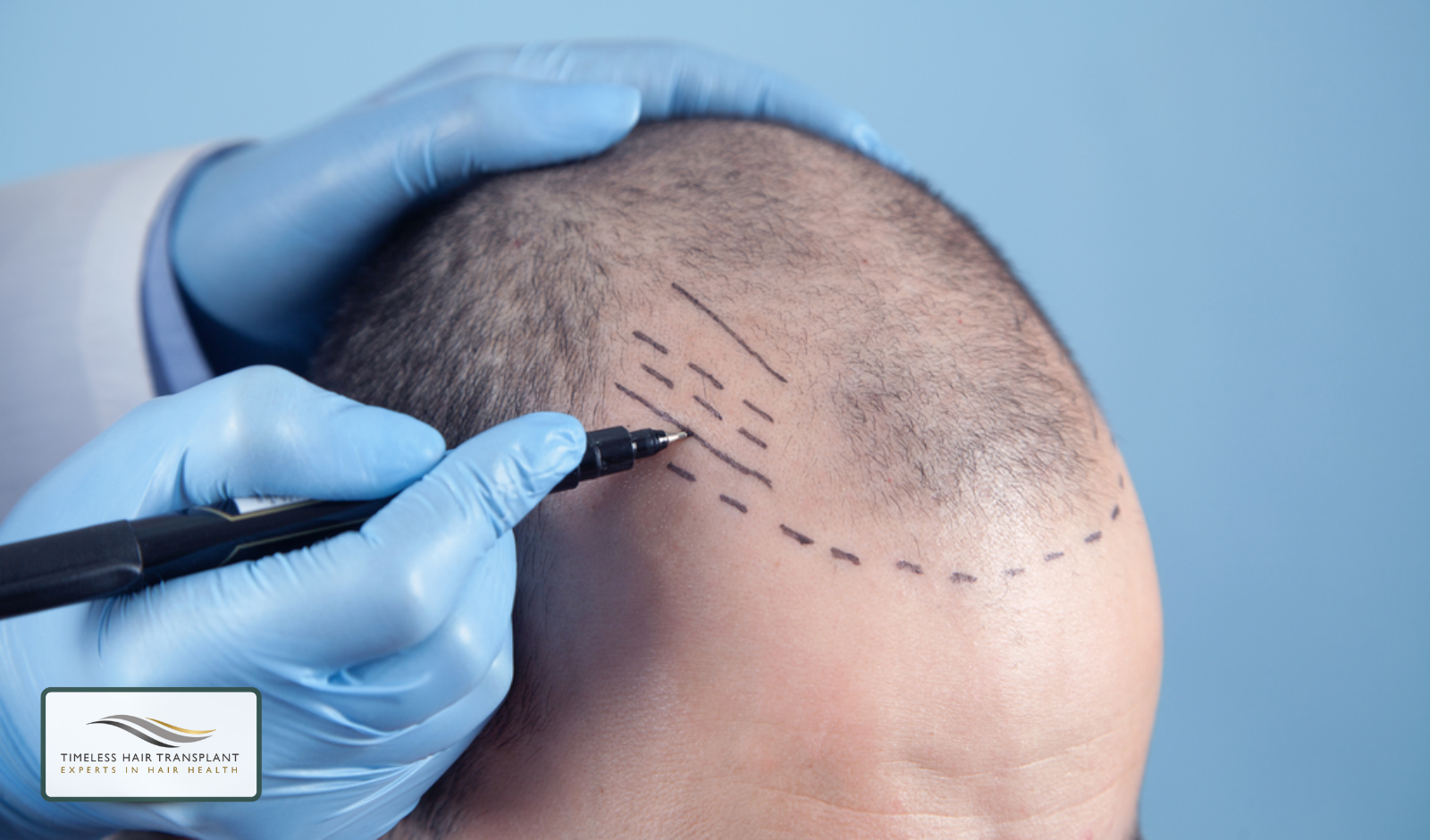Is FUE Hair Transplant Safe? What to Expect
One of the first questions many patients ask is: “Is FUE hair transplant dangerous?” It’s a fair concern, because any surgical procedure comes with some level of risk.
The reassuring news is that FUE hair transplant is considered very safe when performed by an experienced specialist. It’s a minimally invasive technique, carried out under local anaesthetic, with side effects that are usually minor and temporary. In this guide, we’ll explain what to expect during and after surgery, the potential risks, and how to ensure the best outcome.
What Is a FUE Hair Transplant?
An FUE hair transplant is a minimally invasive surgical procedure where individual hair follicles are extracted from a donor area (usually the back or sides of your scalp) and transplanted into thinning or bald areas.
Unlike Follicular Unit Transplantation (FUT), which removes a strip of scalp, the FUE procedure uses tiny punches to remove follicles one by one. This means:
No visible linear scar
Faster healing
Less discomfort after surgery
FUE is popular for treating male pattern baldness, hairline recession, and thinning areas, and it can be suitable for both men and women.
Is FUE Hair Transplant Safe?
Yes, when performed by an experienced hair transplant surgeon at a reputable hair transplant clinic, the FUE procedure is generally considered safe.
Modern hair transplant techniques and advanced surgical tools make the process precise, with high survival rates for transplanted hair follicles. However, as with any form of hair restoration surgery, safety depends on:
The skill of your surgeon
The quality of the clinic’s equipment and hygiene standards
How well you follow post-operation care instructions
Does FUE Hair Transplant Hurt?
One of the biggest concerns people have is discomfort.
During the procedure, a local anaesthetic is used to numb the scalp, so you shouldn’t feel pain while the hair grafts are being removed and implanted into the recipient area. You may feel mild pressure or a tapping sensation.
After surgery, it’s normal to experience:
Mild soreness in the donor area
Slight swelling or redness
Tiny scabs around the recipient sites
These side effects are temporary and usually resolve within 1-2 weeks.
Potential Risks of FUE Hair Transplants
While FUE is generally low risk, possible complications include:
Infection - Rare but possible if the treated area isn’t kept clean.
Swelling - Common for a few days post-surgery.
Graft rejection or failure - Sometimes a few transplant hair follicles may not grow as expected.
Shock loss - Temporary shedding of existing hair near the transplanted area.
Uneven results - Usually due to inexperienced surgeons or poor planning.
These risks are significantly reduced when you choose a trusted clinic with experienced surgeons.
How to Ensure a Safe FUE Procedure
To minimise risks and achieve great hair transplant results:
Choose an Experienced Surgeon - Look for proven experience in both FUE and FUT hair transplants.
Understand the Procedure - Ask about the number of hair grafts, expected hair growth timeline, and recovery plan.
Follow Post-Operation Care - Avoid scratching, contact sports, or strenuous exercise for the first 14 days.
Maintain Scalp Hygiene - Gently clean as instructed to prevent infection.
Attend Follow-Ups - Your surgeon can monitor healing and make adjustments if needed.
Recovery and Healing After FUE
Most patients can return to desk jobs within 2-5 days, but physical activities should be avoided for at least 14 days to reduce the risk of infection or dislodging grafts.
Typical recovery timeline:
Days 1-3: Mild soreness in the donor area, rest recommended.
Week 1: Scabs form around transplanted hairs.
Weeks 2-3: Redness fades; temporary shedding may occur.
Months 3-6: New hair growth begins.
Months 6-12: Full, natural results become visible.
Long-Term Safety and Results
When done correctly, FUE hair transplants are a permanent solution for hair loss. The transplanted follicles are genetically resistant to male pattern baldness, meaning they should continue to grow for a lifetime.
That said, results depend heavily on the skill of your surgeon, proper technique, and how well you follow aftercare guidelines.
Why Choose Timeless Hair Transplant?
At Timeless Hair Transplant, we combine modern techniques with personalised care to deliver safe, natural, and lasting results.
Patients choose us for:
Expert Team - Led by Dr. Luciano Sciacca, providing advanced care in both FUE and FUT hair transplants
Custom Treatment Plans - Tailored to your unique hair loss pattern
Cutting-Edge Technology - Higher survival rates for hair grafts
Comprehensive Aftercare - To prevent complications and promote healthy hair growth
Proven Success Rates - Real transformations and high patient satisfaction
Call us today at +44 (0) 7516294471 to book your free consultation and take the first step toward safe, effective hair restoration.
Frequently Asked Questions
-
No. While an FUE hair transplant is technically a hair transplant surgery, it’s a minimally invasive surgical procedure. It doesn’t require stitches or large incisions, and most patients can return to normal activities within a few days.
-
There are two main types of hair transplantation: Follicular Unit Extraction (FUE) and Follicular Unit Transplantation (FUT). FUE extracts individual hair follicles, while FUT removes a strip of scalp. FUE offers no visible linear scar and faster recovery.
-
The recipient area is the bald or thinning section of the scalp where transplanted hair follicles are implanted. The angle, direction, and density are carefully planned to ensure natural results.
-
Most patients feel only mild discomfort in the donor area and recipient sites for a few days. Over-the-counter medication is usually enough for relief.
-
Initial growth usually starts 3-4 months after the procedure, with full results appearing in 9-12 months.





